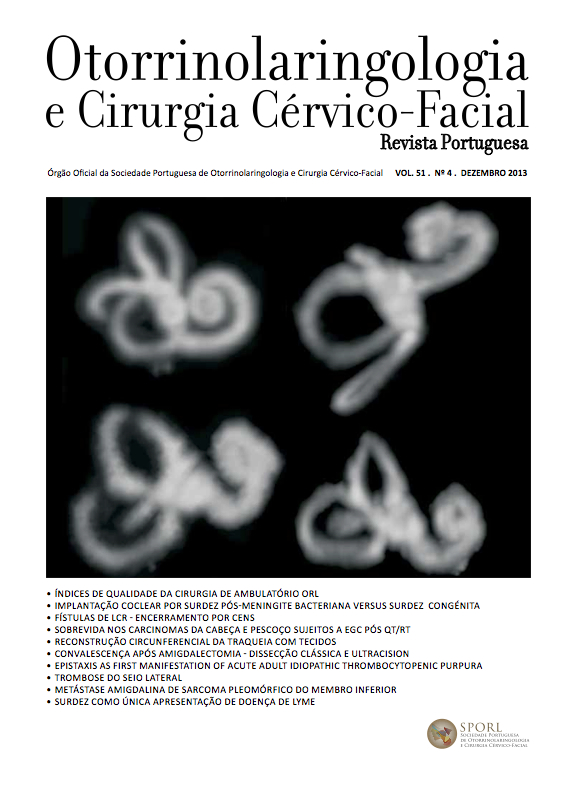Audiometric profile of cochlear implant recipients
DOI:
https://doi.org/10.34631/sporl.2073Keywords:
Hearing loss, Cochlear ImplantAbstract
Objectives: Describe the population of cochlear implant (CI) recipients in one hospital across 9 years.Study design: Retrospective
Material & methods: Hearing evaluation before and after cochlear implantation was obtained using tonal and vocal audiometry (each ear individually and sound field). Cases not suitable for conventional audiometry were tested using visual reinforcement audiometry or Brain Evoked Response Audiometry (BERA).
Results and Conclusions: 37 individuals (46 ears); mean age 35,1 years (min:1; max:74); 62,2% male. In terms of pre-CI hearing, in children there were 3 cases of absent waves on BERA, 6 cases of profound and 2 cases of severe hearing loss. In adults, pure tone average (PTA) pre-CI of the best ear was 91,9 dB (min:72,5; max:103,7). On post-IC audiometric evaluation, in children, PTA was 46,5 dB (min:26; max:71,3). Adults had a PTA of 39,9 dB (mín:22,8; máx:77,5). In terms of vocal audiometry, the maximum of intelligibility for disyllabic words went from 18,1% (min:0; max:80) without CI to 79,5% (min:30; max:100) with CI; p<0,001. Generally speaking, hearing performance of cochlear implant recipients improved.
Downloads
References
Arnoldner C, Lin VY. Expanded selection criteria in adult cochlear implantation. Cochlear Implants Int. 2013 Nov;14 Suppl 4:S10-3. DOI: https://doi.org/10.1179/1467010013Z.000000000123.
Georges FHM. Rastreio e tratamento da surdez com implantes cocleares em idade pediátrica. Norma nº 018/2015 de 11/12/2015 atualizada a 14/07/2017. Direção Geral de Saúde. Disponível em: https://normas.dgs.min-saude.pt/wp-content/uploads/2019/09/rastreio-e-tratamento-da-surdez-com-implantes-cocleares-em-idade-pediatrica.pdf
Alves M, Ramos D, Alves H, Martins JH, Silva L, Ribeiro C. Os questionários mais e muss na avaliação da evolução do desempenho auditivo e comunicativo de crianças utilizadoras de implante coclear. Port J ORL 2023; 53(3):145-8. DOI: https://doi.org/10.34631/sporl.591
O’Donoghue GM, Nikolopoulos TP, Archbold SM. Determinants of speech perception in children after cochlear implantation. Lancet. 2000 Aug 5;356(9228):466-8. DOI: https://doi.org/10.1016/S0140-6736(00)02555-1.
Kang DH, Lee MJ, Lee KY, Lee SH, Jang JH. Prediction of cochlear implant outcomes in patients with prelingual deafness. Clin Exp Otorhinolaryngol. 2016 Sep;9(3):220-5. DOI: https://doi.org/10.21053/ceo.2015.01487.
Rasmussen KMB, West NC, Bille M, Sandvej MG, Cayé-Thomasen P. Cochlear implantation improves both speech perception and patient-reported outcomes: a prospective follow-up study of treatment benefits among adult cochlear implant recipients. J Clin Med. 2022 Apr 18;11(8):2257. DOI: https://doi.org/10.3390/jcm11082257.
Roque Reis L, Castelhano L, Gani K, Correia F, Nunes G, Santos R. et al. Translation, cultural adaptation and contributions to the validation of the Nijmegen Cochlear Implant Questionnaire (NCIQ) for european portuguese. Acta Med Port. 2022 Dec 2;35(12):866-873. DOI: https://doi.org/10.20344/amp.16632.
Dammeyer J, Chapman M. Prevalence and characteristics of self-reported physical and mental disorders among adults with hearing loss in Denmark: a national survey. Soc Psychiatry Psychiatr Epidemiol. 2017 Jul;52(7):807-813. DOI: https://doi.org/10.1007/s00127-017-1397-6.
Downloads
Published
How to Cite
Issue
Section
License
Copyright (c) 2023 The authors retain copyright of this article.

This work is licensed under a Creative Commons Attribution-ShareAlike 4.0 International License.






